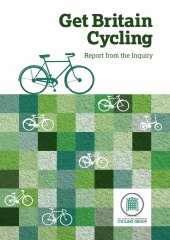Get Britain Cycling - Report from the Inquiry
Document types:
Document weight:
Document geography:
Geographical spread:
Author’s Foreword: Cycling on the Cusp of Greatness
I, like most professional transport planners, providers and researchers of my generation, have grown up thinking that cycling, though worthy, is of small significance compared with the great questions of cars,
traffic and public transport, or the universal significance of walking.
This applies, I think, equally to those who saw the future as building roads for an unending growth in car use, and those who favoured traffic restraint and better public transport – and even those who cycled regularly themselves. We were wrong. The evidence demonstrates quite clearly that, in the words of one witness to the Inquiry, Andy Salkeld, of Leicester City Council, cycling is the mode of transport ‘on the cusp of greatness’.
Its potential is seen already in Cambridge, the flagship city of cycling in Britain, and the potential for rapid and prolonged growth from a low base is seen in many other places as discussed here. The most evident symbol of the complex developments affecting cycling at present is seen in London, a city where cycling overall, at around 2% of all journeys, falls far short of many smaller towns in the UK, and great
cities overseas, yet London boroughs – Hackney, Islington, Lambeth, Wandsworth, Hammersmith and Fulham – are all in the top dozen places in the Census ranking of cycling to work. The rates of growth
compare well with the best; the new technical methodologies, design standards, and political and professional commitment at all levels are of world standard; and already in 2011 there were in total more peak–period cyclists than cars crossing the Thames by the six great bridges of Lambeth, Westminster, Waterloo, Blackfriars, Southwark and London Bridge - an astonishing demonstration of the contribution already made by cycling to traffic flow in the City.
In practical terms for the national average figure around 2%, we should see the important places and developments as having a potential somewhere in the region of 30%-40%, which would put cycling on a
par with any of the other modes. Both experience and statistical analysis suggests that this is achievable, the cost of doing so being in the order of £10-£20 per head of the population per year, sustained for some decades, a figure which would simply accord with cycling having the same share of resources as it currently does of travel. The evidence is that the economic benefits in terms of health and traffic
congestion alone are substantially greater than the cost, and more indirect judgements indicate that the resulting improvement in quality of life and the attractiveness or residential areas and town centres
adds to these benefits.
It is not uncommon for claims to be made which look good on paper but are unrealistic in terms of practical politics or financial constraints. In this case, the signs are very good. An expansion of the role of cycling accords with the different priorities of all the main political parties, and gives scope for politicians to build popularity with their voters, and a remarkable legacy. The time scale is such that effects would build-up over a generation, giving a continuity of attention and policy which would justify the emerging signs of cross-party agreement on strategy and financial commitments.
Phil Goodwin
London April 2013

